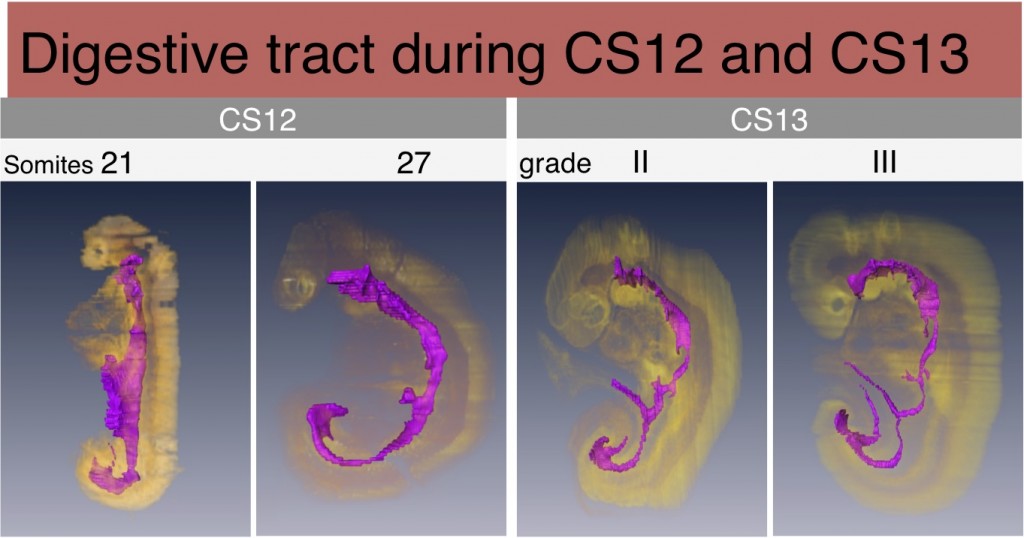上野さんの修論がAnat Recに掲載されました。
Somite stagの胚(CS11-13, 28-33日, 21−35体節)における消化管由来原基の形態と分化のTimeLineを検討
- 消化管と派生した原基は、以下のTimelineに従って発生し、個人差が少ないことを示唆
- 消化管は最初、卵黄嚢の狭小化によって形成される
- 咽頭、肺、胃、肝臓、および背側膵臓原基; CS12-13 の間に分化
- 咽頭嚢; 4 つのペアの分化は、すべての CS13 胚で完了
- 呼吸原基; ≥ 26 体節胚で認められ、CS13 で気管分岐が形成、≥ 35 体節胚で気管伸長。
- 胃; ≥ 34 体節胚で紡錘形
- 肝芽は ≥ 27 体節胚で確認
- 背側膵臓は、3 つを除くすべての CS13 胚で最終的な出芽
- 原始腸ループ ≥ 35 体節の胚形成
今後、消化管関連の異常発生の検出等に有用と考えられます。
22. Ueno S, Yamada S, Uwabe C, Männer J, Shiraki N, Takakuwa T, The digestive tract and derived primordia differentiate by following a precise timeline in human embryos between Carnegie stages 11 and 13, Anatomical Rec 2016, 299(4), 439-449, DOI: 10.1002/ar.23314
ABSTRACT
The precise mechanisms through which the digestive tract develops during the somite stage remain undefined. In this study, we examined the morphology and precise timeline of differentiation of digestive tract-derived primordia in human somite-stage embryos. We selected 37 human embryos at Carnegie Stage (CS) 11–CS13 (28–33 days after fertilization) and three-dimensionally analyzed the morphology and positioning of the digestive tract and derived primordia in all samples, using images reconstructed from histological serial sections. The digestive tract was initially formed by a narrowing of the yolk sac, and then several derived primordia such as the pharynx, lung, stomach, liver, and dorsal pancreas primordia differentiated during CS12 (21–29 somites) and CS13 (≥ 30 somites). The differentiation of four pairs of pharyngeal pouches was complete in all CS13 embryos. The respiratory primordium was recognized in ≥ 26-somite embryos and it flattened and then branched at CS13. The trachea formed and then elongated in ≥ 35-somite embryos. The stomach adopted a spindle shape in all ≥ 34-somite embryos, and the liver bud was recognized in ≥ 27-somite embryos. The dorsal pancreas appeared as definitive buddings in all but three CS13 embryos, and around these buddings, the small intestine bent in ≥ 33-somite embryos. In ≥ 35-somite embryos, the small intestine rotated around the cranial-caudal axis and had begun to form a primitive intestinal loop, which led to umbilical herniation. These data indicate that the digestive tract and derived primordia differentiate by following a precise timeline and exhibit limited individual variations.








